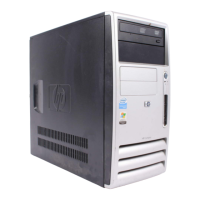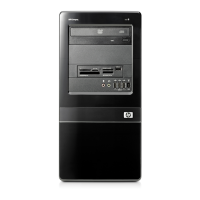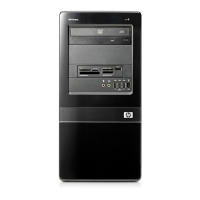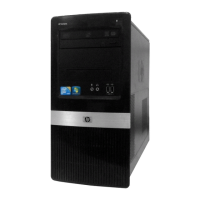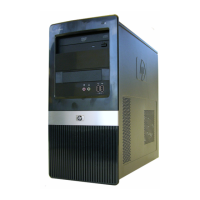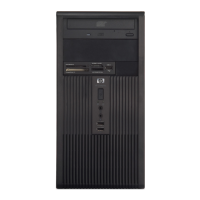Technical Reference Guide www.hp.com 2-17
System Overview
2.4 System Architecture
The systems covered in this guide feature an architecture based on the Intel Q965 Express
chipset (Figure 2-13). All systems covered in this guide include the following key components:
■ Intel Pentium 4, Pentium D, or Core 2 Duo processor.
■ Intel Q965 Express chipset - Includes Q965 GMCH north bridge and 82801 ICH8-DO south
bridge
■ SMC SCH5317 super I/O controller supporting PS/2 keyboard and mouse peripherals
■ ALC262 audio controller supporting line in, line out, microphone in, and headphones out
■ Intel 82566DM 10/100/1000 network interface controller
The Q965 chipset provides a major portion of system functionality. Designed to compliment the
latest Intel processors, the Q965 GMCH intefaces with the processor through a
533/800/1066-MB Front-Side Bus (FSB) and communicates with the ICH8-DO component
through the Direct Media Interface (DMI). The integrated graphics controller of the Q965 may
be upgraded through a PCI Express x16 graphics slot. All systems include at least one PCI 2.3
slot and feature as standard a serial ATA (SATA) hard drive. The USDT model supports a
Slimline Optical Drive through a legacy parallel ATA 100 interface.
Table 2-3 lists the differences between models by form factor.
Notes:
[1] Supports an ADD2 card in the reverse-layout. or a PCIe x16 graphics card (with PCIe riser card
installed)
[2] Slot not accessible if PCI riser is installed.
[3] Full-height slot (requires PCI riser)
[4] Low-profile slots without PCI riser, full-height slots with optional PCI riser
[5] Requires adapter.
[6] 2nd serial port requires adapter
Table 2-3.
Architectural Differences By Form Factor
Model USDT SFF ST MT CMT
Memory sockets 3 4 4 4 4
PCI Express x16
graphics slot?
Yes [1] Yes [2] Yes [2] Yes Yes
# of PCI Express x1
slots
0 Yes [2] Yes [2] Yes Yes
# of PCI 2.3 slots 1 [3] 2 [4] 2 [4] 2 4
Serial / parallel ports Optional [5] Standard [6] Standard [6] Standard [6] Standard [6]
SATA interfaces 1 3 3 4 4

